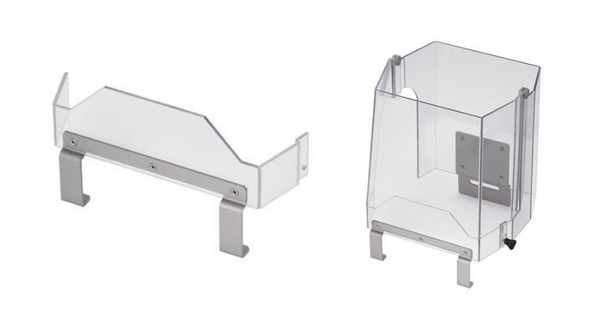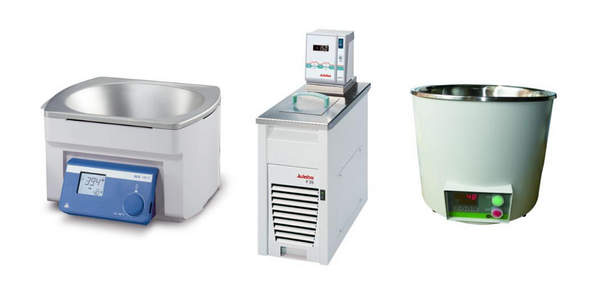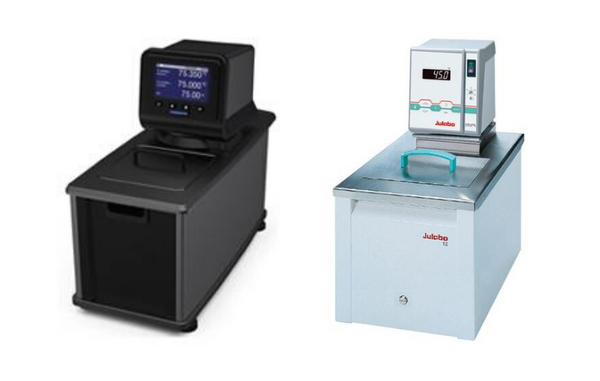Dealing with warm or hot oil can be dangerous for a number of reasons. Here are some of the main hazards associated with using an oil bath:
- When dealing with hot oil, there is a risk of fire. It’s crucial that you know the safe working temperature of your oil.
- Overheating samples can cause the release of noxious fumes and even explosions.
- Hot oil can severely burn your skin or eyes. Even a small splash can cause damage.
- Flasks that have been immersed in oil can be very slippery, making it easy to drop and break them.
In this post we discuss tips to help you mitigate the risks involved with using an oil bath. Note that the below advice assumes you are using a high-temperature bath designed specifically for heating oil to high temperatures. The other option is to use a vessel containing oil with a hotplate. Much of the same advice applies when using a hotplate, but this method comes with additional risks, such as the formation of hotspots and the risk of fire if the vessel containing the oil cracks or breaks. From a safety standpoint, you’re better off using a specially-designed high-temperature bath where possible.
Tips for Using an Oil Bath Safely
Aside from wearing the appropriate personal protective equipment, here are some tips to ensure you stay safe while using your oil bath:
- Don’t overheat your oil
- Use the safest setup possible
- Take care during your application
- Avoid leaving your bath unattended
- Store oil properly
Let’s look at these in more detail:
1. Don’t Overheat Your Oil
It’s imperative that you know the safe working temperature of your oil, and the set temperature of your bath should always be lower than the oil’s flash point. Watch out for smoke as this typically means the oil has been heated beyond its safe working temperature range, and could easily ignite. Oil that has been smoking should not be reused and should be disposed of. If you notice your oil is dark brown in color, it has likely been overheated and should be disposed of.
Similarly, you should be careful not to heat your sample higher than is safe. If certain mixtures are overheated in a water or oil bath, the result could be the release of noxious fumes or even an explosion.
2. Use the Safest Setup Possible
Ensure your bath is sitting on a flat, stable surface. For example, using an oil bath on a movable trolley is not a good idea as accidental movement could cause hot oil to spill or splash. When setting up your equipment, you should consider how easily you can remove your vessel from the bath in case of overheating.
It’s also important not to overfill your oil bath, to avoid spillage once your vessel is submerged. Note that oil expands when heated, so this should be considered as well.
If you’re deciding whether to use a fume hood, consider that in case of fire, a fume hood can help to contain the fire, limiting the risk of injury and damage. A fume hood helped keep a bad situation from getting worse when a fire started in an overheated hotplate oil bath at Berkeley University.
Some baths have optional safety accessories available for purchase. For example, IKA makes a shield and a protective cover for the HB 10 Heating Bath. The shield offers protection against hot liquid splashes and can be used inside a fume hood. If you’re unable to work in an extractor hood, the larger protective cover is a better option.

The HB 10.1 Shield and the HB 10.2 Protective Cover.
If you’re shopping for a bath and want to choose the safest option, go with a fully enclosed model (if your application allows for it). For example, most circulators have fully-enclosed designs.
3. Take Care During Your Application
Here are a few things to bear in mind during your application:
- Ensure you have appropriate spill cleanup materials on hand, for example, granular clay absorbents, in case anything does go wrong.
- Ensure you don’t leak water or other substances into the bath. Water, in particular, can cause splattering and “popping.”
- Take care when handling glassware that has been immersed in oil as it will be very slippery. Use absorbent towels to wipe off the oil and consider using tongs to handle vessels.
4. Avoid Leaving Your Bath Unattended
If possible, avoid leaving your oil bath unattended. If you do need to leave it, the set temperature should be well below the oil’s flash point. Some baths come with safety features to help avoid risks of overheating.
For example, HB 10 Heating Baths comes with a safety temperature cut-off and a lock function that prevents accidental changing of set conditions. The Refrigerated 4.5 Liter Heating Circulators and HB03 Series High Temperature Baths also have an adjustable high-temperature cut-off built in.

Left to right: A HB 10 Heating Bath, a Refrigerated 4.5 Liter Heating Circulator, and a HB03 Series High Temperature Bath.
5. Store Oil Properly
Always store your oil bath in a place that is away from all heat sources. If it has a cover, use this for storage (most of our high temperature baths come with covers). If not, use aluminum foil to cover the bath when not in use (if you’re leaving oil in it).

PolyScience 7 Liter Integrated Heated Baths and a Julabo Heating Circulators 12 Liter come with covers.
Before storing, label heating oil with its safe working temperature range. This provides quick and easy access to important information for you and your colleagues.
